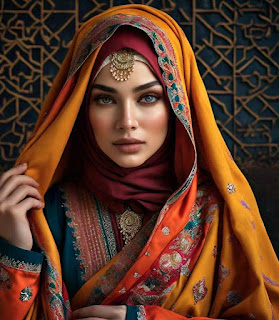Introduction Kashmiri Abaya
The Kashmiri Abaya, also known as the Phiran, is a traditional garment worn by women in Kashmir, a region in the Indian subcontinent. It is a long, loose-fitting tunic that falls to the ankles, typically worn with a scarf or shawl, and is an integral part of Kashmiri culture and identity. The Abaya has a rich history, dating back to the Mughal era, and has evolved over time to become an iconic symbol of Kashmiri heritage.
The Kashmiri Abaya represents a fusion of cultural heritage and Islamic modesty, reflecting the unique blend of traditions in the region. Characterized by its loose-fitting silhouette and intricate embroidery, the Kashmiri Abaya offers both elegance and modesty to the wearer. Influenced by the rich artistic traditions of Kashmir, the Abaya showcases delicate patterns and motifs inspired by nature, such as flowers, vines, and paisleys, meticulously crafted by skilled artisans. While adhering to the principles of modest dressing in Islam, the Kashmiri Abaya also serves as a symbol of cultural identity, with its distinct design distinguishing it from other styles of Abayas found in different regions. Whether worn for religious ceremonies, special occasions, or everyday wear, the Kashmiri Abaya embodies the timeless beauty and cultural pride of Kashmir, celebrating its rich heritage while embracing the values of modesty and grace.
History of the Kashmiri Abaya
The origins of the Kashmiri Abaya can be traced back to the 16th century, during the reign of the Mughal Empire in India. The Mughals brought with them their own style of clothing, which included long, flowing tunics and robes. The Kashmiri Abaya was influenced by these Mughal designs, and over time, it became a distinct garment that reflected the region's cultural and social identity.
During the 19th century, the Abaya underwent significant changes, with the introduction of new fabrics, colors, and designs. The British colonial era also had an impact on the Abaya, as Kashmiri women began to adopt European-style clothing, leading to a fusion of styles and influences.
Design and Fabric of the Kashmiri Abaya
The Kashmiri Abaya is known for its intricate designs, vibrant colors, and high-quality fabrics. Traditional fabrics used to make the Abaya include wool, silk, and cotton, often embroidered with intricate patterns and motifs. The Abaya is typically made in a loose, flowing style, with long sleeves and a high neckline.
The designs on the Abaya are inspired by Kashmir's natural beauty, with motifs such as flowers, leaves, and birds. The colors used are also significant, with red and green being the most popular, symbolizing prosperity and good fortune.
Occasions and Wear
The Kashmiri Abaya is worn on various occasions, both formal and informal. It is a staple garment for traditional festivals and celebrations, such as Eid and Narvon. The Abaya is also worn for everyday purposes, such as visiting family and friends, or attending cultural events.
In formal settings, the Abaya is often paired with a scarf or shawl, and adorned with jewelry and ornaments. For informal occasions, the Abaya may be worn with a pair of trousers or a skirt, and accessorized with a simple scarf or hat.
Styling and Accessorizing
The Kashmiri Abaya offers a range of styling options, depending on the occasion and personal preference. For formal events, the Abaya is often paired with a matching scarf or shawl, and adorned with traditional jewelry such as the "Dejhor" (a silver or gold chain worn around the neck).
For everyday wear, the Abaya may be styled with a pair of trousers or a skirt, and accessorized with a simple scarf or hat. The Abaya can also be worn with a belt or sash, to add a touch of elegance and sophistication.
Modern Twists and Fusion
In recent years, the Kashmiri Abaya has undergone a modern transformation, with designers incorporating new fabrics, colors, and designs. The Abaya has been fused with other cultural influences, such as Western-style clothing, to create a unique and contemporary look.
Modern twists on the Abaya include the use of bold colors and patterns, as well as innovative fabrics such as velvet and silk. The Abaya has also been adapted for different occasions, such as wedding wear and party wear.
Significance and Cultural Importance
The Kashmiri Abaya is more than just a garment; it is a symbol of Kashmiri identity and culture. It represents the region's rich history, its people's resilience, and their love for beauty and elegance.
The Abaya is also an important part of Kashmiri tradition and heritage, passed down from generation to generation. It is a reminder of the region's cultural and social values, and its significance cannot be overstated.
Conclusion
In conclusion, the Kashmiri Abaya is a timeless and elegant garment that has been an integral part of Kashmiri culture for centuries. Its rich history, intricate designs, and vibrant colors make it a unique and iconic symbol of Kashmiri heritage. The Abaya's significance extends beyond its beauty, representing the region's cultural and social identity, and its people's love for tradition and elegance.
The Kashmiri Abaya stands as a unique embodiment of cultural heritage and religious tradition in the region. With its exquisite embroidery, loose-fitting silhouette, and rich symbolism, the Kashmiri Abaya not only serves as a garment of modesty but also as a proud expression of Kashmiri identity and craftsmanship. Through centuries of evolution and adaptation, it has retained its timeless elegance while reflecting the diverse influences that have shaped Kashmiri culture. As a symbol of both faith and culture, the Kashmiri Abaya continues to captivate with its beauty and significance, resonating with wearers and admirers alike as a cherished emblem of tradition and pride.








0 Comments